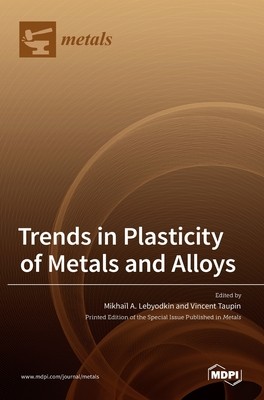
- We will send in 10–14 business days.
- Publisher: MDPI AG
- ISBN-10: 3036515615
- ISBN-13: 9783036515618
- Format: 17 x 24.4 x 1.8 cm, hardcover
- Language: English
- SAVE -10% with code: EXTRA
Trends in Plasticity of Metals and Alloys (e-book) (used book) | bookbook.eu
Reviews
Description
The last few decades have seen considerable progress in the development of high-performance metals and alloys that have microstructures and plastic behaviors with a high level of complexity. Ultrafine-grain materials, metallic glasses, gradient microstructures, etc., have clearly been gaining the attention of researchers and are gaining a place in the industry. Concurrently, the self-organized nature of plastic deformation, leading to complex behaviors on mesoscopic scales even in pure metals with highly symmetric lattices, has been generally recognized. Such progress has demanded the development of sophisticated experimental techniques (in situ TEM, digital image correlation, nano-indentation, etc.), advanced multiscale modeling (molecular dynamics, discrete dislocation dynamics, strain gradient models, etc.), and methods of analysis of the observed and simulated behaviors from the viewpoint of self-organization, with an aim of filling gaps between the elementary atomic-scale mechanisms and the scale of a laboratory sample. The current research has evolved in two main areas. First, new approaches to old questions and traditional model materials allow for a deeper understanding of physical mechanisms. Second, a better understanding of the process-microstructure-property links provides a basis for the elaboration of new materials and processing routes, as well as for the creation of powerful computer models that are able to predict the behavior of complex materials. This Special Issue aims at presenting examples of such recent progress and trends in the plasticity of metals and alloys.
EXTRA 10 % discount with code: EXTRA
The promotion ends in 17d.20:34:09
The discount code is valid when purchasing from 10 €. Discounts do not stack.
- Publisher: MDPI AG
- ISBN-10: 3036515615
- ISBN-13: 9783036515618
- Format: 17 x 24.4 x 1.8 cm, hardcover
- Language: English English
The last few decades have seen considerable progress in the development of high-performance metals and alloys that have microstructures and plastic behaviors with a high level of complexity. Ultrafine-grain materials, metallic glasses, gradient microstructures, etc., have clearly been gaining the attention of researchers and are gaining a place in the industry. Concurrently, the self-organized nature of plastic deformation, leading to complex behaviors on mesoscopic scales even in pure metals with highly symmetric lattices, has been generally recognized. Such progress has demanded the development of sophisticated experimental techniques (in situ TEM, digital image correlation, nano-indentation, etc.), advanced multiscale modeling (molecular dynamics, discrete dislocation dynamics, strain gradient models, etc.), and methods of analysis of the observed and simulated behaviors from the viewpoint of self-organization, with an aim of filling gaps between the elementary atomic-scale mechanisms and the scale of a laboratory sample. The current research has evolved in two main areas. First, new approaches to old questions and traditional model materials allow for a deeper understanding of physical mechanisms. Second, a better understanding of the process-microstructure-property links provides a basis for the elaboration of new materials and processing routes, as well as for the creation of powerful computer models that are able to predict the behavior of complex materials. This Special Issue aims at presenting examples of such recent progress and trends in the plasticity of metals and alloys.


Reviews